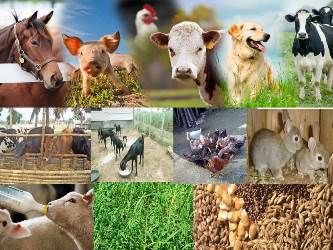



Received: 28-Nov-2022, Manuscript No. GJASLPAB-22-84099 ; Editor assigned: 02-Dec-2022, Pre QC No. GJASLPAB-22-84099 (PQ); Reviewed: 16-Dec-2022, QC No. GJASLPAB-22-84099 ; Revised: 23-Dec-2022, Manuscript No. GJASLPAB-22-84099 (R); Published: 30-Dec-2022, DOI: 10.35841/2408-5499.22.10.175
A zoonotic disease is any infectious condition that may spread from animals, wild or domestic, to humans. Animals can transmit bacterial, viral, parasite, fungal, or fungi-based diseases to people by bites, scratches, vectors, or ingestion. Zoonotic diseases are divided into different groups based on how they spread, such as foodborne or vector-borne, the sorts of pathogens they are caused by, such as micro parasites, viruses, bacteria, protozoa, worms, ticks, or fleas, or how easily they can be passed from one person to another (Ferré, et al., 2020).
Animals kept as pets or domesticated by humans coexist closely with them. These animals may contain infections that can impair human health and are communicable to humans. Zoonotic illnesses are problematic for world health. Rabies, Human African Trypanosomiasis (HAT), brucellosis, bovine tuberculosis, cysticercosis, echinococcosis, and anthrax are listed as the endemic diseases of concern in the World Health Organization (WHO) Report 2006 (Berhe, et al., 2003). These illnesses have detrimental social, economic, and health repercussions on communities. When someone is infected, they lose their ability to work, and their close friends and family must pay for their care and treatment. The family's resources may be severely depleted by the time and money spent looking for a cure.
Prioritizing their prevention and management is crucial due to the diverse public health burden and socioeconomic effects of zoonotic diseases throughout time and in different geographic contexts. As bacteria take advantage of new niches and adapt to new hosts, the recent and historical appearance of zoonoses can be seen as a logical result of both pathogen and human ecology and pathogen evolution. Most of the time, human activity, such as modifications in land use, resource extraction, animal production methods, contemporary transportation, antimicrobial medication use, and international trade, mediates access to these novel niches. People have altered the environment in which core ecological principles that determine how these infections survive and change have stayed constant. Animal domestication, land clearance for agriculture, grazing, and wildlife hunting in new habitats have all contributed to zoonotic human infection with diseasecausing bacteria. Each livestock revolution era brought us new health issues and chances for zoonotic infections to originate as human cultures advanced. Numerous diseases, especially zoonotic diseases, have appeared and disappeared over time due to the changing and growing interdependence of humans, animals, and the ecosystem (Abraham 2009).
Increased population, economic growth, technological advancements, and farming intensification have all had an impact on culture, resulting in greater direct interactions between people and animals. In recent years, greater regional trade, travel, soaring human and cattle populations, and changing cultural norms have all been related to an elevated risk of disease development and the potential for pervasiveness. This justifies the requirement for ongoing disease surveillance, tracking, and knowledge of the cultural epidemiology of zoonotic illnesses (Abraham, et al., 2005).
People's cultures, traditions, norms, knowledge, attitude, and practises are social components of epidemiology that influence the transmission, management, and eradication of many zoonotic illnesses. According to studies, understanding zoonoses' reservoirs and how they spread to humans has made early diagnosis, reporting, and control of these diseases possible. Individuals and societies differ in their understanding of specific diseases. Evidence suggests that people's attitudes toward and actions and behaviours related to the diseases in question are influenced by their perceptions of disease risks, such as transmission and health repercussions.
Producers, traders, and several other market participants make up the intricate chain that makes up the livestock trade system, which is referred to here as the livestock trade. Animals are transported from households to the final consumer or terminal market via a variety of markets and trade channels. The livestock trade is heavily based on several unofficial networks involving individual meat and cattle traders (Tarawali, et al., 2011).
The livestock keepers, who raise the animals and decide whether to sell them, are among the variables in the trade of livestock. The purchase and sale of animals is the business of some dealers. Animal trekkers are people whose job it is to walk cattle from houses to marketplaces or across markets. are mostly involved in bringing possible sellers and purchasers together. The member states of the East African Community (EAC) have a similar and their borders are very permeable to unauthorised animal and human migration, which is common in nations with sparse animal husbandry.
Abraham A (2009). Agricultural biotechnology research and development in Ethiopia. Afric J Biotec. 8(25). [CrossRef] [Google Scholar]
Abraham G, Sintayehu A, Libeau G, Albina E, Roger F, Laekemariam Y, Abayneh D, Awoke KM (2005). Antibody seroprevalences against peste des petits ruminants (PPR) virus in camels, cattle, goats and sheep in Ethiopia. Prev Vet Med.70(1-2):51-57. [CrossRef] [Google Scholar] [Pubmed]
Berhe G, Minet C, Le Goff C, Barrett T, Ngangnou A, Grillet C, Libeau G, Fleming M, Black DN, Diallo A (2003). Development of a dual recombinant vaccine to protect small ruminants against peste-des-petits-ruminants virus and capripoxvirus infections. J Virol.77(2):1571-1577. [CrossRef] [Google Scholar] [Pubmed
Ferré LB, Kjelland ME, Strøbech LB, Hyttel P, Mermillod P, Ross PJ (2020) Recent advances in bovine in vitro embryo production: Reproductive biotechnology history and methods. Animal.14(5):991-1004 . [CrossRef] [Google Scholar] [Pubmed]
Tarawali SM, Herrero K, Descheemaeker E, Grings, Blümmel M. (2011). Pathways for sustainable development of mixed crop livestock systems: Taking a livestock and pro-poor approach. Livestock Sci. 139:11-21. [Crossref] [Google Scholar]